|
How
To Make Out To A Monster Movie
By Will 'the Thrill" Viharo
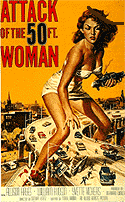 In
this 21st century post-drive-in pop cultural wasteland, where
does a swingin’ couple of hell-bent hipsters go for that most
old-fashioned yet timeless indulgence, that flimsy yet fun excuse
to hold sweaty hands and seek solace in each others’ amorous arms,
the Creature Double Feature? The answer is sadly simple: Nowhere.
You stay home, because the coolest pad in town is probably the
one you decorated yourself, properly equipped with the modern
luxuries of the hedonistic homebody: a hi-fi stereo system, microwave,
blender, cocktail bar, and of course, a VCR. In
this 21st century post-drive-in pop cultural wasteland, where
does a swingin’ couple of hell-bent hipsters go for that most
old-fashioned yet timeless indulgence, that flimsy yet fun excuse
to hold sweaty hands and seek solace in each others’ amorous arms,
the Creature Double Feature? The answer is sadly simple: Nowhere.
You stay home, because the coolest pad in town is probably the
one you decorated yourself, properly equipped with the modern
luxuries of the hedonistic homebody: a hi-fi stereo system, microwave,
blender, cocktail bar, and of course, a VCR.
Unless
you’re lucky enough to live in the environs of Oakland, CA, where
I host cult movies in “Thrillville Theater” every week at The
Parkway Speakeasy Theater, or unless your local drive-in not only
still exists but actually shows flicks meant for this classic
venue, you will have to resort to entertaining your date in your
own private drive-in. But keep that vintage roadster in the garage
where it belongs—you can now make out to these original drive-in
monster movies from the comfort and safety of your own couch.
Plus, the snack bar is only a few steps away, and ideally, there
won’t be a line (except the one you’re using to score).
The
following list of suggested Creature Double Features, along with
the basic accoutrements and refreshments required for the successful
indoor drive-in experience, includes vintage monster movies originally
made for the drive-in back in its heyday, the ‘50s and ‘60s, that
are currently available on video:
INDOOR
DRIVE-IN DATE #1:
I
Was A Teenage Werewolf with Invasion of the Saucer Men
(both 1957, American International Pictures; available on RCA
Columbia Home Video).
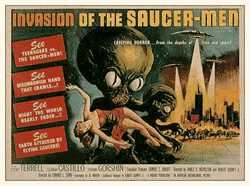 This
twin-bill of teen terror was the one that started it all. In the
mid-50s, theater operator James Nicholson and entertainment lawyer
Sam Arkoff decided to put their talents and know-how together
to form their own film distribution company. Their simple but
brilliant scheme was to target the one demographic that had been
ignored by mainstream marketing execs: teenagers. Television was
taking its toll on box office receipts, and entire theater chains
were folding fast. Nicholson and Arkoff hired enterprising upstarts
like Roger Corman to make economic exploitation double bills that
promised more thrills than a tiny TV screen could ever hope to
offer. Nicholson was a genius for thinking up titles, and then
all that was needed was a poster to go with it. For that they
hired people like the great Al Kallis. Once the poster and title
were sold to exhibitors, the rest was easy—just make the film.
The fledgling company, originally called ARC (American Releasing
Corporation), was re-dubbed American International Pictures in
1956. Already gaining ground with teenagers, who had plenty of
money, passions and rubber(s) to burn, AIP scored its first major
hit with the double feature I Was A Teenage Werewolf and
Invasion of the Saucer Men. Each movie clocks in at around
75 minutes, since the two were made to be sold as part of a double
bill, a package deal that excited exhibitors found extremely profitable. This
twin-bill of teen terror was the one that started it all. In the
mid-50s, theater operator James Nicholson and entertainment lawyer
Sam Arkoff decided to put their talents and know-how together
to form their own film distribution company. Their simple but
brilliant scheme was to target the one demographic that had been
ignored by mainstream marketing execs: teenagers. Television was
taking its toll on box office receipts, and entire theater chains
were folding fast. Nicholson and Arkoff hired enterprising upstarts
like Roger Corman to make economic exploitation double bills that
promised more thrills than a tiny TV screen could ever hope to
offer. Nicholson was a genius for thinking up titles, and then
all that was needed was a poster to go with it. For that they
hired people like the great Al Kallis. Once the poster and title
were sold to exhibitors, the rest was easy—just make the film.
The fledgling company, originally called ARC (American Releasing
Corporation), was re-dubbed American International Pictures in
1956. Already gaining ground with teenagers, who had plenty of
money, passions and rubber(s) to burn, AIP scored its first major
hit with the double feature I Was A Teenage Werewolf and
Invasion of the Saucer Men. Each movie clocks in at around
75 minutes, since the two were made to be sold as part of a double
bill, a package deal that excited exhibitors found extremely profitable.
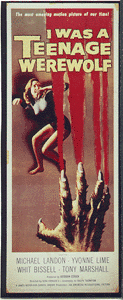 Teenage
Werewolf was groundbreaking in several respects: not only
did it feature one of the most-parodied titles of all time, but
it offered the big screen starring debut of Michael Landon, who
went on to find fame and fortune on the Ponderosa and the Prairie.
To me, it was downhill from here: Landon was the James Dean of
lycanthropes. With the fast-paced, sensitive direction of Gene
Fowler, Jr. (once an editor for Fritz Lang), and the moody photography
of Joseph LaShelle (who won an Oscar for Laura), Teenage Werewolf
was a unique, unprecedented hybrid of genres: a JD horror noir.
Paul Dunlap’s score added just the right touch of melancholia,
creating a hauntingly nostalgic portrait of savage youth, which
the first teenage drive-in generation related to in record numbers.
The co-feature, Invasion of the Saucer Men, was directed
by B movie specialist Edward Cahn, with an appropriately spoofy/spooky
score by Ronald Stein. This dark little tale of teenagers, hot
rods, and outer space invaders is actually a sci-fi comedy with
some cool atmospheric chills along the way. Frank Gorshin, a frequent
AIP player, turns in a great comic performance a decade before
his famous stint as “The Riddler” on Batman. The bulb-headed,
cat eyed aliens were created by Paul Blaisdel, a former comic
book/pulp artist hired by AIP to make some of their most memorable
monsters, from the Saucer Men to The She Creature to the cucumber-shaped
alien Beulah in It Conquered the World (see Indoor Drive-In
Date #5). The Saucer Men were the obvious inspiration for the
Martians in Mars Attacks, both the trading cards and Tim
Burton’s terrific 1996 film. Teenage
Werewolf was groundbreaking in several respects: not only
did it feature one of the most-parodied titles of all time, but
it offered the big screen starring debut of Michael Landon, who
went on to find fame and fortune on the Ponderosa and the Prairie.
To me, it was downhill from here: Landon was the James Dean of
lycanthropes. With the fast-paced, sensitive direction of Gene
Fowler, Jr. (once an editor for Fritz Lang), and the moody photography
of Joseph LaShelle (who won an Oscar for Laura), Teenage Werewolf
was a unique, unprecedented hybrid of genres: a JD horror noir.
Paul Dunlap’s score added just the right touch of melancholia,
creating a hauntingly nostalgic portrait of savage youth, which
the first teenage drive-in generation related to in record numbers.
The co-feature, Invasion of the Saucer Men, was directed
by B movie specialist Edward Cahn, with an appropriately spoofy/spooky
score by Ronald Stein. This dark little tale of teenagers, hot
rods, and outer space invaders is actually a sci-fi comedy with
some cool atmospheric chills along the way. Frank Gorshin, a frequent
AIP player, turns in a great comic performance a decade before
his famous stint as “The Riddler” on Batman. The bulb-headed,
cat eyed aliens were created by Paul Blaisdel, a former comic
book/pulp artist hired by AIP to make some of their most memorable
monsters, from the Saucer Men to The She Creature to the cucumber-shaped
alien Beulah in It Conquered the World (see Indoor Drive-In
Date #5). The Saucer Men were the obvious inspiration for the
Martians in Mars Attacks, both the trading cards and Tim
Burton’s terrific 1996 film.
SUGGESTED
MENU: Teenage Werewolf is a perfect ’50s time capsule,
and hamburgers, fries and shakes will help create a vintage malt
shop atmosphere. The Saucer Men pose one seriously weird
threat: Their claws are filled with alcohol! Their victims die
from alcohol poisoning! Get loaded fast pounding shots of tequila
every time the aliens stab Frank Gorshin!
INDOOR
DRIVE-IN DATE #2:
The
Blob (Paramount, 1958) with The Giant Claw (Columbia,
1957), both available from Goodtimes home video.
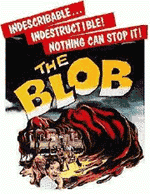 Steve
McQueen has been posthumously crowned the King of Cool (of course,
Dean Martin shares that throne). The Blob, McQueen’s feature
film debut, did for monster movies what his big hit Bullitt
(1967) did for cop movies by providing the genre with one unforgettable
scene for the ages. Of course the latter has the famous San Francisco
car chase. The Blob has that killer sequence where the
titular menace attacks a movie theater full of screaming kids
watching the great obscure nightmare noir Daughter of Horror
(narrated by Ed McMahon!). Despite its campy approach, this is
actually a very effective little classic, in color with a theme
song by none other than Burt Bacharach. The Giant Claw,
on the other hand, is flat-out one of the funniest movies ever
made—even if that accomplishment is completely accidental. The
sight of the screaming giant alien chicken is enough to put you
in the hospital. Genre giants Mara Corday and Jeff Morrow (see
more of both in Indoor Drive-In Date #6) had no idea what they
were supposed to be afraid of while filming this classic turkey
(or chicken…whatever), directed to react to an invisible terror
that would be added in later, during post-production. At the screening,
they found out, and to their ultimate mortification discovered
the audience was screaming too—with laughter. Steve
McQueen has been posthumously crowned the King of Cool (of course,
Dean Martin shares that throne). The Blob, McQueen’s feature
film debut, did for monster movies what his big hit Bullitt
(1967) did for cop movies by providing the genre with one unforgettable
scene for the ages. Of course the latter has the famous San Francisco
car chase. The Blob has that killer sequence where the
titular menace attacks a movie theater full of screaming kids
watching the great obscure nightmare noir Daughter of Horror
(narrated by Ed McMahon!). Despite its campy approach, this is
actually a very effective little classic, in color with a theme
song by none other than Burt Bacharach. The Giant Claw,
on the other hand, is flat-out one of the funniest movies ever
made—even if that accomplishment is completely accidental. The
sight of the screaming giant alien chicken is enough to put you
in the hospital. Genre giants Mara Corday and Jeff Morrow (see
more of both in Indoor Drive-In Date #6) had no idea what they
were supposed to be afraid of while filming this classic turkey
(or chicken…whatever), directed to react to an invisible terror
that would be added in later, during post-production. At the screening,
they found out, and to their ultimate mortification discovered
the audience was screaming too—with laughter.
SUGGESTED
MENU: Buffalo wings and Jello shots!
INDOOR
DRIVE-IN DATE #3:
The
Amazing Colossal Man (AIP, 1957), available from RCA Columbia
home video, with Attack of the 50 Foot Woman (Allied Artists,
1958), available from Fox home video.
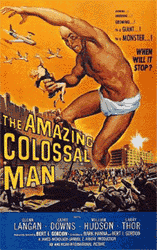 Drive-in
director Bert I. Gordon’s initials are B.I.G, and he lived up
to ‘em. He specialized in fright flicks about mutated giants,
whether grasshoppers in Beginning of the End (1957) or
a tarantula in Earth vs. the Spider (1958). In this absolute
must-see, his most famous hit, B.I.G. brings us the atomic tale
of Col. Glenn Manning, transformed after exposure to a radioactive
blast into a bald, diaper-wearing, neurotic madman who grows to
be 60 feet tall before taking a destructive stroll through Las
Vegas (back when it was still a swinger’s paradise—I wish he’d
go on a rampage now and destroy the Disneyesque desecration Vegas
has become). The obvious co-feature is the female answer to the
amazing Mr. Colossal, buxom beauty Allison Hayes in the camp cult
masterpiece Attack of the 50 Foot Woman, also starring
sultry Yvette Vickers, who unwisely tries to steal Big Mama’s
man. Almost as funny as The Giant Claw, but also somewhat
touching, too. Beware the giant rubber hand! Drive-in
director Bert I. Gordon’s initials are B.I.G, and he lived up
to ‘em. He specialized in fright flicks about mutated giants,
whether grasshoppers in Beginning of the End (1957) or
a tarantula in Earth vs. the Spider (1958). In this absolute
must-see, his most famous hit, B.I.G. brings us the atomic tale
of Col. Glenn Manning, transformed after exposure to a radioactive
blast into a bald, diaper-wearing, neurotic madman who grows to
be 60 feet tall before taking a destructive stroll through Las
Vegas (back when it was still a swinger’s paradise—I wish he’d
go on a rampage now and destroy the Disneyesque desecration Vegas
has become). The obvious co-feature is the female answer to the
amazing Mr. Colossal, buxom beauty Allison Hayes in the camp cult
masterpiece Attack of the 50 Foot Woman, also starring
sultry Yvette Vickers, who unwisely tries to steal Big Mama’s
man. Almost as funny as The Giant Claw, but also somewhat
touching, too. Beware the giant rubber hand!
SUGGESTED
MENU: BIG bowl of popcorn, BIG bag of chips, BIG bottle of soda,
BIG case of booze. Surround yourselves with tiny toy cars, plastic
soldiers, etc. Later in the evening, pretend you’re the stars
of the evening’s film selections: strip down to your underwear
and wrestle to see who comes out on top!
INDOOR
DRIVE-IN DATE #4:
The
Creature from the Black Lagoon (Universal, 1954), available
from MCA home video, with The Monster of Piedras Blancas
(1959), available from Republic Pictures home video.
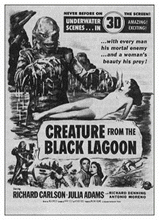 Rubber-suited
monsters rule! Forget the cold, calculated CGI effects of today’s
jaded junk—check out these two exotic examples of ancient aquatic
humanoids on the rampage in a modern world gone mad! Jack Arnold
directed the first (and second) in the famous Creature
trilogy, and it was an immediate hit, securing Universal as the
classic monster movie studio after their successful Frankenstein,
Dracula, Wolf Man and Invisible Man franchises
from the‘30s and ’40s had been done to death. The Gill Man is
the ’50s Monster Poster Boy—even Marilyn waxed poetic about Gill
in The Seven Year Itch. He is also this fan’s all-time
favorite monster. (And to me, the two sequels, Revenge of the
Creature and The Creature Walks Among Us, are equally
essential, so feel free to switch the premiere installment with
either of these worthy successors). Gill’s influence can still
be felt, and a remake has again been announced. Yawn. The original
can never be equaled. But I still love the Creature knock-offs
that immediately followed, like The She Creature (AIP,
1956, currently not on video) and The Monster of Piedras Blancas,
a low-budget re-working of the same basic premise, starring pin-up
doll Jeanne Carmen as the object of the beast’s affections. This
rubber suit is actually scarier than Gill’s! Word has it the real
town of Piedras Blancas screens their dubious claim to fame once
a year. You won’t have to wait or go that far. Rubber-suited
monsters rule! Forget the cold, calculated CGI effects of today’s
jaded junk—check out these two exotic examples of ancient aquatic
humanoids on the rampage in a modern world gone mad! Jack Arnold
directed the first (and second) in the famous Creature
trilogy, and it was an immediate hit, securing Universal as the
classic monster movie studio after their successful Frankenstein,
Dracula, Wolf Man and Invisible Man franchises
from the‘30s and ’40s had been done to death. The Gill Man is
the ’50s Monster Poster Boy—even Marilyn waxed poetic about Gill
in The Seven Year Itch. He is also this fan’s all-time
favorite monster. (And to me, the two sequels, Revenge of the
Creature and The Creature Walks Among Us, are equally
essential, so feel free to switch the premiere installment with
either of these worthy successors). Gill’s influence can still
be felt, and a remake has again been announced. Yawn. The original
can never be equaled. But I still love the Creature knock-offs
that immediately followed, like The She Creature (AIP,
1956, currently not on video) and The Monster of Piedras Blancas,
a low-budget re-working of the same basic premise, starring pin-up
doll Jeanne Carmen as the object of the beast’s affections. This
rubber suit is actually scarier than Gill’s! Word has it the real
town of Piedras Blancas screens their dubious claim to fame once
a year. You won’t have to wait or go that far.
SUGGESTED
MENU: Seafood! Polynesian drinks like Mai Tai’s would also be
a propos.
INDOOR
DRIVE-IN DATE #5
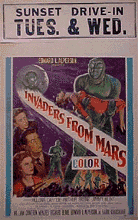 It
Conquered the World (AIP, 1956), available from RCA Columbia
home video, with Invaders from Mars (1953), available from
Wade Williams home video. It
Conquered the World (AIP, 1956), available from RCA Columbia
home video, with Invaders from Mars (1953), available from
Wade Williams home video.
Aliens
from outer space taking over human forms in order to infiltrate
our society was a big theme in the ’50s, often cited as an allegory
for the era’s communist xenophobia. Everyone has seen the most
famous example, Don Siegel’s 1956 classic Invasion of the Body
Snatchers. Here are two that are just as subversive, with
their own styles. Roger Corman proved he was already well on his
way to achieving drive-in immortality when he gave us It Conquered
the World, the cynical sci-fi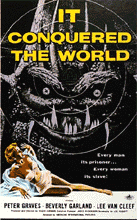 cult classic featuring Paul Blaisdel’s cucumber-shaped mind-controlling
Venusian, Beulah (aka, “Cuddles”). It Conquered co-starred
a grave Peter Graves, screaming star Beverly Garland, spaghetti
western icon Lee Van Cleef as the insane dupe, and really cool
’50s-era ranch-style houses. Set designer cum director Cameron
Menzies’ Invaders from Mars actually pre-dates Body Snatchers,
and for many it’s the ultimate children’s nightmare, shot in gorgeous
three-strip Technicolor and featuring many stunning, surreal images
of a hostile alien takeover in an otherwise idyllic suburban world.
In the end, of course, it’s revealed to have been a dream—or was
it precognition?
cult classic featuring Paul Blaisdel’s cucumber-shaped mind-controlling
Venusian, Beulah (aka, “Cuddles”). It Conquered co-starred
a grave Peter Graves, screaming star Beverly Garland, spaghetti
western icon Lee Van Cleef as the insane dupe, and really cool
’50s-era ranch-style houses. Set designer cum director Cameron
Menzies’ Invaders from Mars actually pre-dates Body Snatchers,
and for many it’s the ultimate children’s nightmare, shot in gorgeous
three-strip Technicolor and featuring many stunning, surreal images
of a hostile alien takeover in an otherwise idyllic suburban world.
In the end, of course, it’s revealed to have been a dream—or was
it precognition?
SUGGESTED
MENU: Cucumber salad, sandwiches with lots of pickles, veggies
‘n’ dip.
INDOOR
DRIVE-IN DATE #6:
Tarantula
(Universal, 1955) with This Island Earth (Universal, 1955),
both available from MCA home video.
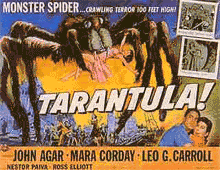 Universal
Studios was the home of all the classic monsters of gothic yore,
but in the ’50s, the masses were obsessed with atom-splitting
experiments and the constant threat of a nuclear holocaust, the
monsters were atomic-powered. Universal was just as successful
and memorable in this “modern” era as in the fog-shrouded heyday
of vampires, mummies and werewolves. Big Bugs were a big deal
in the atomic ’50s, and many cite 1954’s classic giant ant thriller
Them!, which started the trend, as the ultimate Big Bug movie.
My favorite Big Bug movie, however, is Tarantula, Universal’s
answer to Warner Brother’s ants. Not only does it have a scarier
monster seen more often, with equally effective special effects,
but it also has a sub-plot involving human mutations, genre faves
Mara Corday and John Agar, and even Clint Eastwood in a cameo
as a jet fighter pilot naplaming the titular arachnid! The bleak,
haunting, mysterious desert setting was ubiquitous in‘50s sci
fi - largely due to 1953’s It Came From Outer Space, another
classic sci-fi film from Tarantula’s director Jack Arnold
(see Indoor Drive-In Date #4). In the same year as Tarantula,
Universal also released their all-time classic outer space extravaganza Universal
Studios was the home of all the classic monsters of gothic yore,
but in the ’50s, the masses were obsessed with atom-splitting
experiments and the constant threat of a nuclear holocaust, the
monsters were atomic-powered. Universal was just as successful
and memorable in this “modern” era as in the fog-shrouded heyday
of vampires, mummies and werewolves. Big Bugs were a big deal
in the atomic ’50s, and many cite 1954’s classic giant ant thriller
Them!, which started the trend, as the ultimate Big Bug movie.
My favorite Big Bug movie, however, is Tarantula, Universal’s
answer to Warner Brother’s ants. Not only does it have a scarier
monster seen more often, with equally effective special effects,
but it also has a sub-plot involving human mutations, genre faves
Mara Corday and John Agar, and even Clint Eastwood in a cameo
as a jet fighter pilot naplaming the titular arachnid! The bleak,
haunting, mysterious desert setting was ubiquitous in‘50s sci
fi - largely due to 1953’s It Came From Outer Space, another
classic sci-fi film from Tarantula’s director Jack Arnold
(see Indoor Drive-In Date #4). In the same year as Tarantula,
Universal also released their all-time classic outer space extravaganza
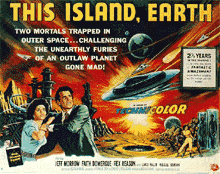 This
Island Earth, recently parodied in the Mystery Science
Theater 3000 movie. Not that this flick really warrants satire—the
beautiful three-strip Technicolor, the big-brained Metaluna insect-mutants,
the otherworldly ambience and the square-jawed acting of Jeff
Morrow and Rex Reason will wipe that smirk off your face. As a
bonus, there’s Faith Domergue as the pretty ingenue. This film
ranks right up there with Forbidden Planet as interstellar
entertainment. Lounge lizard fact: Both Tarantula and This
Island Earth feature unbilled musical cues scored by Henry
Mancini! This
Island Earth, recently parodied in the Mystery Science
Theater 3000 movie. Not that this flick really warrants satire—the
beautiful three-strip Technicolor, the big-brained Metaluna insect-mutants,
the otherworldly ambience and the square-jawed acting of Jeff
Morrow and Rex Reason will wipe that smirk off your face. As a
bonus, there’s Faith Domergue as the pretty ingenue. This film
ranks right up there with Forbidden Planet as interstellar
entertainment. Lounge lizard fact: Both Tarantula and This
Island Earth feature unbilled musical cues scored by Henry
Mancini!
SUGGESTED
MENU: Anything small and squishy, like escargot, so you can feel
you’re dominating the insect world rather than vice versa.
INDOOR
DRIVE-IN DATE #7:
Angry
Red Planet (1960) available from MGM home video, with The Atomic
Submarine (1960), available from Image Home Entertainment.
The
great things about drive-ins was that you could go anywhere while
parked in your car, from outer space to the depths of the ocean.
With this pair of B movie babies, you can do both in the same
evening, parked on the same couch. Angry Red Planet was
partly shot in a weird tinted process called Cinemagic, and you
get to experience Mars as this pink psychedelic planet inhabited
by strange creatures like a giant rabbit-bat-crab-spider monster
(the film’s centerpiece)! When you’re not on Mars you’re in some
alternate Earth world (meaning you can see it only in the movies)
populated by hot babes and clean cut men, so it’s an all-around
good time. The Atomic Submarine is a true oddity, combining
a plot and props right out of the classic TV series Voyage
to the Bottom of the Sea with the already-old monster from
outer space bit, this time portrayed as a submerged giant one-eyed
thingie that talks in a deep, serious voice like a math professor.
Trust me, this is far more entertaining than over-bloated tripe
like The Abyss, which this ambient little gem pre-dates
by almost three decades.
SUGGESTED
MENU: Spiked fruit punch, devilled eggs (or anything that looks
like an alien cyclops).
INDOOR
DRIVE-IN DATE #8:
Horror
of Dracula (Hammer, 1958), available from Warner Brothers
home video, with The Awful Dr. Orloff (1960), available
on video from Image Entertainment.
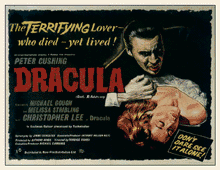 The
Europeans weren’t nearly as prudish as Americans when it came
to sex (though they did edit out our violence)—at the drive-in
in those days, if you didn’t see sex in your car, you wouldn’t
see any at all. Unless, of course, you went to an imported horror
movie. Hammer Studios of England re-invented the gothic horror
genre amid the atomic terrors of the American ’50s, beginning
in 1957 with the ground-breaking gory hit The Curse of Frankenstein,
starring future icons Peter Cushing and Christopher Lee, and then
cemented their budding reputation as the new kings of horror with
the sanguinary smash Horror of Dracula, starring the same
popular pair. Lee’s Count is the definitive interpretation, for
my money, even more so than Lugosi: he’s sexy, sinister, and suave.
This is not only the best in the long-running Dracula series,
starring Lee, but this is also Hammer’s all-around best movie,
which is saying a lot. For a completely decadent evening of foreign
intrigue, pair this with the even sleazier Spanish classic The
Awful Dr. Orloff, Jesse Franco’s first big hit in this country,
and the first horror flick to actually show what others only hinted
at: nudity! It goes by fast, but it is there, so no blinking.
The depraved goings-on and mad skin-grafting experiments are abetted
by the blind man-monster Morpho, the insane Dr. Orloff’s rather
frisky assistant. But hey, it’s from Europe—so it’s an art film!
Expect your date to initiate some fear-induced cuddling. The
Europeans weren’t nearly as prudish as Americans when it came
to sex (though they did edit out our violence)—at the drive-in
in those days, if you didn’t see sex in your car, you wouldn’t
see any at all. Unless, of course, you went to an imported horror
movie. Hammer Studios of England re-invented the gothic horror
genre amid the atomic terrors of the American ’50s, beginning
in 1957 with the ground-breaking gory hit The Curse of Frankenstein,
starring future icons Peter Cushing and Christopher Lee, and then
cemented their budding reputation as the new kings of horror with
the sanguinary smash Horror of Dracula, starring the same
popular pair. Lee’s Count is the definitive interpretation, for
my money, even more so than Lugosi: he’s sexy, sinister, and suave.
This is not only the best in the long-running Dracula series,
starring Lee, but this is also Hammer’s all-around best movie,
which is saying a lot. For a completely decadent evening of foreign
intrigue, pair this with the even sleazier Spanish classic The
Awful Dr. Orloff, Jesse Franco’s first big hit in this country,
and the first horror flick to actually show what others only hinted
at: nudity! It goes by fast, but it is there, so no blinking.
The depraved goings-on and mad skin-grafting experiments are abetted
by the blind man-monster Morpho, the insane Dr. Orloff’s rather
frisky assistant. But hey, it’s from Europe—so it’s an art film!
Expect your date to initiate some fear-induced cuddling.
SUGGESTED
MENU: Any Euro cuisine, with red wine. Lots of red wine. Or Bloody
Marys, of course.
INDOOR
DRIVE-IN DATE #9:
The
Hideous Sun Demon (1959) available from the Wade Williams
Sci-Fi Gold Collection, with The Brain That Wouldn’t Die
(1959), available from Rhino home video and MGM home video.
A
stylish evening of sleaze awaits you with this double-shot of
sun, fun and sin. Robert Clarke is one of the nicest guys I’ve
ever met - he was also in the sci fi classics The Man From
Planet X and Beyond the Time Barrier, among many other
films, in all genres. But he will always be best remembered for
his ultimate gig, as the star, director and producer of The
Hideous Sun Demon, which inverts the werewolf legend by having
the tormented titular lizard-man turn in the daytime. This movie
scared the hell out of me when I was a little tyke—now it plays
like a really cool private eye movie with a monster in it! Watch
for the mess in the Sun Demon’s pants—both sides—as he climbs
up a ladder! It looks like a very weak bladder, but that was really
Robert Clarke sweating to death inside the incredible rubber suit
during a LA heatwave. The stock music on the soundtrack was later
used as the score for Night of the Living Dead! (Oddly,
I also recently noticed it on the premiere episode of The Untouchables.)
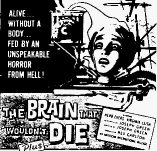 The
Brain That Wouldn’t Die was made in‘59 but wasn’t released
until ’62—like with any mental patient, I guess they had trouble
convincing the outside world to accept this crazy, violent, sex-obsessed
menace into polite society. This is absolutely the sleaziest movie
I’ve ever seen, at least in black and white—a demented doctor
starts looking for a voluptuous body to attach to the head of
his decapitated girlfriend which he keeps alive in his basement!
Also locked away in a closet is another horribly botched experiment
waiting to break loose and wreak havoc! Killer sax on the soundtrack,
grindhouse-style strippers and a terrific catfight are only a
few of the many decadent delights that are buried in this bargain-basement
beauty. The
Brain That Wouldn’t Die was made in‘59 but wasn’t released
until ’62—like with any mental patient, I guess they had trouble
convincing the outside world to accept this crazy, violent, sex-obsessed
menace into polite society. This is absolutely the sleaziest movie
I’ve ever seen, at least in black and white—a demented doctor
starts looking for a voluptuous body to attach to the head of
his decapitated girlfriend which he keeps alive in his basement!
Also locked away in a closet is another horribly botched experiment
waiting to break loose and wreak havoc! Killer sax on the soundtrack,
grindhouse-style strippers and a terrific catfight are only a
few of the many decadent delights that are buried in this bargain-basement
beauty.
SUGGESTED
MENU: Brain food and lounge lizard cocktails. Rub suntan lotion
on each other during the dull parts, and there will be several.
INDOOR
DRIVE-IN DATE #10:
Robot
Monster (1953) with Catwomen on the Moon (1953), both
available from Rhino home video.
The
3D craze came and went in the ’50s, and you’ll see why for yourself
when you don the glasses that accompany both of these videos,
two original 3D Z Grade kitsch masterpieces, both at least as
hilarious as The Giant Claw. Robot Monster’s director (so
to speak—he basically edited together a lot of stock footage with
superimposed bubbles), Phil Tucker, reportedly tried to kill himself
shortly after the making of this movie. The Robot Monster himself,
a gorilla costume with a deep sea diver’s helmet, has become a
symbol of sorts for Bad Cinema, a dubious honor, to say the least.
Catwomen on the Moon rivals Queen of Outer Space
as the most outrageously sexist pin-ups-on-another-planet movie
ever made. The dialogue has to be heard to be believed—but I can
tell you, it wasn’t meant to be as hilarious as it is, it just
turned out that way. That’s the beauty of it. You won’t be able
to tell if your headache is from laughter or eye strain, but it
won’t matter, both flicks are short and fast and well worth the
suffering they induce.
SUGGESTED
MENU: Junk food, baby. Junk food.
Will
Viharo runs the Thrillville Revue in San Francisco, CA.
For details ckeck out www.thrillville.net.
|










